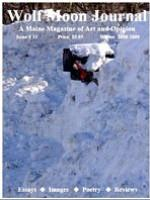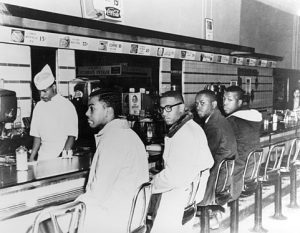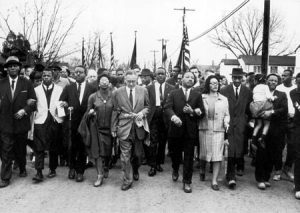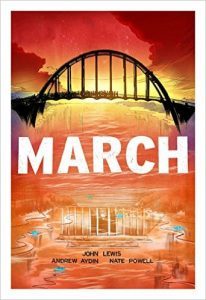Kathy Lynn Emerson's Blog, page 53
January 27, 2017
Weekend Update: January 28-29, 2017
 Next week at Maine Crime Writers, there will be posts by Dorothy Cannell (Monday) Kaitlyn Dunnett/Kathy Lynn Emerson (Tuesday), Kate Flora (Wednesday), Bruce Coffin (Thursday) and Brenda Buchanan (Friday).
Next week at Maine Crime Writers, there will be posts by Dorothy Cannell (Monday) Kaitlyn Dunnett/Kathy Lynn Emerson (Tuesday), Kate Flora (Wednesday), Bruce Coffin (Thursday) and Brenda Buchanan (Friday).
In the news department, here’s what’s happening with some of us who blog regularly at Maine Crime Writers:
Big News From Malice Domestic: Three Maine Crime Writers are among the finalists for the Agatha Award. Nominees are:
Fogged Inn by Barbara Ross for Best Contemporary Novel
Whispers Beyond the Veil by Jessica Estevao (aka Jessie Crockett) for Best Historical Novel
A Good Man with a Dog: A Game Warden’s 25 Years in the Maine Woods by Roger Guay with Kate Clark Flora for Best Nonfiction
Obviously there’s some great writing coming out of the state of Maine. Malice Domestic is a convention in Bethesda, MD for folks who love reading (and writing) traditional mysteries. This year it takes place from April 28-30. For more details go to Malice Domestic
Bruce Robert Coffin will be speaking at the Scarborough Historical Society, 649 Route 1, Scarborough, Maine on February 1st at 7:00 pm.
An invitation to readers of this blog: Do you have news relating to Maine, Crime, or Writing? We’d love to hear from you. Just comment below to share.
And a reminder: If your library, school, or organization is looking for a speaker, we are often available to talk about the writing process, research, where we get our ideas, and other mysteries of the business. Contact Kate Flora
January 26, 2017
Maya’s Heritage
John Clark celebrating the publication of a really good young adult urban fantasy by my friend Laurie Graves. She’s guest blogged here a few times and many may remember her and husband Clif as the creators and publishers of Wolf Moon Journal. Beth and I, as well as daughters Sara and Lisa were contributors to various issues and it was that publication which got me started writing book reviews, something I do plenty of these days. Below is my review of Maya, followed by highlights I had with Laurie and Clif over coffee last week.
Maya and the Book of Everything by Laurie Graves, Hinterlands Press, 2016. ISBN: 9780997845303. Reviewed by John R. Clark, MLIS.
From the moment you meet Maya on a Boston bound train until the very surprising twist at the end which so smoothly sets up the next book, you’re in for an adventure.
Maya’s bound for East Vassalboro, Maine for the summer. Still hurt and angry about her father’s abandonment and new family in North Carolina, she and her artist mom are spending more than their traditional month this time. When she notices a grim and evil looking man a few seats down on the train, she realizes the object of his attention is a nervous looking young woman further down the compartment. Sensing something amiss, Maya creates a distraction while walking past him and the woman who drops something in her messenger bag.
The mystery object turns out to be a book, and what a book it is! Maya learns it’s Earth’s edition of The Book of Everything, a volume that constantly changes, has unique powers and can interact with certain people, Maya being one of them. There are evil people who want the book as well as a group of dedicated librarians who are equally determined to protect it.
Once her bond with the book forms, Maya’s life changes in unexpected ways. Time no longer stays constant, the book takes her to a neighborhood ion Waterville years before where she meets Andy, a boy two years older than Maya who’s fifteen. Meeting him is just an intermediate step, leading to another world where she finds a toad queen, an ancient oak, feuding brothers, magic and another side trip to The Great Library where Books of Everything are carefully crafted for worlds all over the universe.
This is an excellently crafted urban fantasy, one that teens and adults will like a lot. Maine and librarians play significant roles in the story and Maya and Andy are strong and very likable protagonists. Laurie has created a full and intriguing world with equally intriguing characters. It’s an excellent choice for both school and public libraries.
When chatting about the book, I was most intrigued at how it came about. Laurie was editing an issue of Wolf Moon when she discovered that her go-to resource, The Chicago Manual of Style didn’t have all the answers needed. That started an inner dialogue about how a book that had everything in it might come about. Next came the idea for the story-one about a strong girl with family issues who was willing to act bravely. When Laurie attended a Christmas concert and saw a young girl who was a participant, she became the mental image of Maya and the book took off.
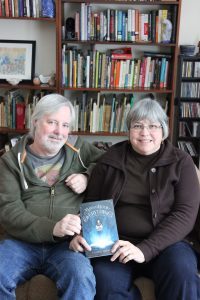
Clif and Laurie with Maya in hand
Themes integral to the story came next: Maya’s darker coloring from her Franco-American heritage, the idea of setting parts of the story in a tight knit neighborhood and the importance of generational interaction (readers will note Maya’s role as the family spokesperson). Libraries have always been important to Laurie (she currently serves on the board at the Bailey Library in Winthrop), something she inherited from her dad. The Vassalboro and Waterville libraries were critical to her growing up years. She noted that one of the blessings of growing up in New England was the large and strong library system. Almost every town has one, but sadly, they must fight continually for an adequate budget.
I asked her what books influenced her growing up. The Wizard of Oz, Alice in Wonderland, A Wrinkle in Time, The Hobbit and the Lord of the Rings as well as fiction by Farley Mowatt were her immediate responses. In fact, she wished that she could have written A Wrinkle in Time and The Lord of the Rings.
Maya’s story became a serious project following the cessation of Wolf Moon Journal. The first draft got a year long incubation, followed by numerous revisions and several rejections. The decision to self publish it wasn’t made lightly, but went forward when daughter Dee, an editor for a major NYC publisher, offered to pay for professional cover art as well as work on the editing. Laurie and Clif both noted how helpful Google Translator was in the editing process.
There were further adventures when Clif started the import process from a word processor into Scribus (his page layout of choice). It was done as plain text, but the process stripped out quote marks and italics, neither apparent until the first proof was printed. He noted that quotes were easy to fix, italics not so much. Fonts were also a challenge since many are copyrighted and expensive. He settled on Garamond-Crimson Text. Both agreed that a professional copy editor will be high on their list for the next book. Creating the ebook version in both epub and mobi came next, using Ultimate Ebook Creator to do it.
Maya goes to another world called Albion in the story, so I asked Laurie how she chose it and was told Albion is an old name for England. Likewise the society there and the two brothers in conflict are loosely based on Shakespeare’s The Tempest. In fact Laurie said that astute readers will find numerous references to Shakespeare in the story. Two themes she wants readers to understand. Facts do matter and Maya is at its core, a book about family. Book two Library Lost is planned for the fall of 2018.
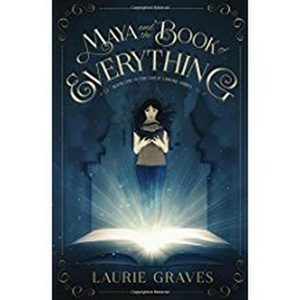
This photo doesn’t do the cover art justice.
In celebration of Maya’s debut, I’m giving a signed copy of Maya and the Book of Everything to one reader who comments on the blog post.
January 24, 2017
The Professional Aunt
dispatched from Key West by Barb
 Over Christmas, my son Rob found a book in my mother-in-law’s apartment, titled, The Professional Aunt. He brought it to me because he found it funny. We have a long tradition of auntdom in our family, a role currently being vigorous pursued by his sister, Kate, with his daughter, Viola.
Over Christmas, my son Rob found a book in my mother-in-law’s apartment, titled, The Professional Aunt. He brought it to me because he found it funny. We have a long tradition of auntdom in our family, a role currently being vigorous pursued by his sister, Kate, with his daughter, Viola.
The book, by Mary C. E. Wemyss, was published in the U.S. in 1910 by Houghton Mifflin. The story is plainly set in England, and I’m guessing it may have been published there first. It’s a light, funny work of fiction, told in the first person, about the trials of a single woman whose sisters-in-law decide her perfect role in the family is to be the doting aunt. She, however, wants more, including the chance to have her own romance. She is constantly thwarted, until, of course, the end.
Here’s the beginning–
A boy’s profession is not infrequently chosen for him by his parents, which perhaps accounts for the curious fact the the shrewd, business-like member of the family often becomes a painter, while the artistic, unpractical one becomes a member of the stock exchange, in course of time, naturally.
My profession was forced on me, to begin with, by my sisters-in-law, and in the subsequent and natural order of things by their children–my nephews and nieces.
There’s a handwritten note in the front of the book that says:
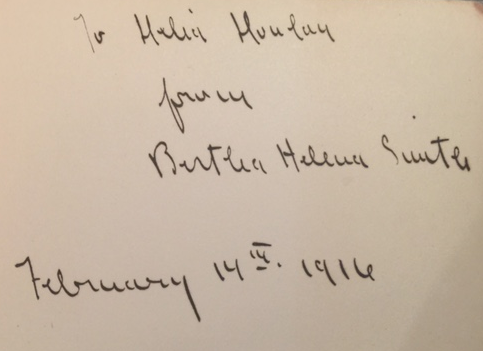
The giver, Bertha Helena Smith, turns out to be easy to find. Various genealogical sites all confirm she was born in Vernon, Wisconsin on March 17, 1889 to Leander Smith and Helena Calvert. She married Barnhard Adelbert Clausius and had 7 children. She passed away on October 14, 1972 in Hillsboro, Wisconsin.
I had no luck tracking down the receiver, Melia Murphy. (If that’s even what that says. I can’t actually read it.) Poking around, I had the brainstorm she might be Amelia Murphy, but that got me nowhere. I would think a Murphy would be easier to find than a Smith, but let’s face it, neither one is a prize. When I am trying to make a suspect unGoogleable by my sleuth, my first choice is always a common name.
What route the book took from Wisconsin, if that’s indeed where it was given, to New England, where my mother-in-law purchased it, I can’t begin to guess.
The author, Mary C. E. Wemyss, proved much harder to track down than Bertha Helena Smith. Due to places like Amazon, eBay and Abebooks, books never disappear. But the author herself eluded me, though she was cited in at least two recent Ph.D. dissertations on the role of servants in literature. Finally, I spotted a reference to Mrs. George Wemyss, which got me to this.
Wemyss, Mrs George: Mary Lutyens (b. 1868) married George Wemyss. Eldest daughter among fourteen children (she had eight elder brothers).
So I guess she knew something about having sisters-in-law and being an aunt.
Then I found this:
MRS. GEORGE WEMYSS (1868-????), (pseudonym of Mary Wemyss, née Lutyens). Children’s author and novelist; sister of architect Edwin Lutyens; according to OCEF, her novels often focus on children; titles include The Professional Aunt (1910), People of Popham (1911), Impossible People (1918), and Oranges and Lemons (1919)
Her books don’t really focus on children, except one that is told from a child’s point of view. And then this.
[Mrs. Wemyss] is an Englishwoman with a most interesting personality. She comes of a Danish family the Lutyens and many of her ancestors have served in the English army. Her father was a soldier and when a young man serving in Canada was Master of the Montreal Hounds. After the Crimea he retired and became a painter and an intimate friend of Sir Edwin Landseer. He is now 81 years old and still rides to hounds.
So Mary Wemyss (pronounced Weems), author of more than ten books published in England and America, gets to be defined for posterity in terms of her husband, brother, and father. Admittedly her brother (of the ubiquitous garden benches) was pretty famous, but still.
Tucked into the pages of The Professional Aunt, I found five newspaper clippings:
A definition of “The Dark Ages,” unknown newspaper, undated.
A definition of “The Renaissance,” unknown newspaper, undated.
An article about Claude Monet, still painting in France, at 80 years old, in part to prove to the world he is not blind. unknown paper, 1923, exact date unknown.
“On the Record, The Lord Is Risen Indeed”, by Dorothy Thompson, New York Tribune, April 11, 1936. A bone-chilling article about the successful removal of the Jews from the German egg trade, followed by a quote from Hitler threatening a “final solution,” and a plea for monetary contributions for Jewish resettlement. There follows a discussion of the celebration of Easter in the Catholic south and the Protestant north of Germany and how both have been twisted by the propaganda of Nazism. It ends with this quote, “It was Nietzche who said, ‘the first and last Christian died upon the cross.’ Sometimes one thinks it is true.”
“A Song in Your Heart” by Agnes Carr, Boston Traveler, December 1941, an inspirational poem about getting through dark times.
I leave it to you, dear readers to muse about Mary C. E. Wemyss, Bertha Helena Smith, Melia Murphy (?) and the person, whoever it was, who tucked those articles into the book. Whomever you imagine, I am sure they will be fascinating characters.

Save
Save
Save
Save
Save
Save
January 23, 2017
The Best Part of Writing: The Research
In my last book, The Darkest Thread, teenage sisters go missing in Vermont’s mysterious Bennington Triangle, and it’s up to K-9 search and rescue handler Jamie Flint and her dogs to find them. Naturally, lots of unsavory things happen and it’s not nearly as easy as you’d think, before the mystery is ultimately solved and the search is done. I spent a lot of time on reading, interviews, and treks for that novel, including talking to a multitude of K-9 search and rescue handlers. That, to me, is one of the best parts of this whole writing gig. Oh, sure, the writing can be lovely, actually having a completed book is great, and I’m invariably tickled when the royalties come in… The readings and the signings and the readers are, likewise, Very Good Things in this business. But having an excuse to go out and do stuff that I’ve always wanted to do but otherwise may be too timid — that pretty much rocks.
In my next Flint K-9 Search and Rescue novel, two guides and a group of at-risk teens in a wilderness expedition school vanish while out dog sledding. I think you see where I’m going with this.
Yes indeed.
Sunday afternoon, I drove the hour and a half up to Bethel and settled in at the Inn at the Rostay, a rustic, no-frills little place on Route 2 that was perfect for my purposes. There was a microwave and a fridge, a comfortable bed with a handmade quilt, free Wifi, and a doable price tag. Definitely everything I was looking for.
The next morning, Caroline Blair-Smith — co-owner of Mornington Crescent Sled Dogs — picked me up in her truck, and we headed out. The truck was equipped with a special rig containing eight separate compartments for the dogs, while the sled was perched atop that. From there, we were off.
I’m not going to go into great detail here about the whole adventure, except to say… Well, it was awesome and I highly recommend giving it a whirl if it’s something you have any interest in. I knew Caroline from my days working at Hurricane Island Outward Bound School, so I knew I would be in good hands, the dogs would be well cared for, and she would be able to answer any questions I might have. I was right on all three counts. And because a picture truly is worth a thousand words, here are some shots of my day out on the trail.

Caroline Blair-Smith getting the sled and gear set for our trek.

Caroline and her dogs barreling toward me on the trail.

The team anxiously waiting to get back on the trail.

A view of the mountains and forest during our trip.
Those are just a few of the shots I got while out on the trail. I will note that it’s a lot harder to take photos than you’d think when your fingers are cold and the world is whizzing by and you’re trying to hang on to a sled behind eight very eager pups who just want to move. So, less photos than I might have gotten otherwise, but I wanted my focus to be more on the experience itself than on recording the whole thing for posterity. I’m pleased at making that decision, though, because I feel like I’m much better prepared to describe the whole thing for the book than I would have been if I’d been worrying about framing the perfect shot. Someday, perhaps I’ll figure out how to do both.
Jen Blood is author of the USA Today-bestselling Erin Solomon mysteries and the newly released The Darkest Thread, the first novel in the Flint K-9 Search and Rescue Mysteries. To learn more, visit www.jenblood.com.
January 22, 2017
HOW AROOSTOOK COUNTY VETERANS TOOK ON THE VA—And WON!

Vaughn
Last year the Marine Corps League Detachment in which I am the second in command (officially the Senior Vice-Commandant) in conjunction with Cary Medical Center in Caribou began a quest. We wanted to establish two things: (1) an advisory committee made up of members from the various veterans groups in Aroostook County and (2) a long-term facility in which homeless veterans could be housed until they got back on their feet. I had no idea what I was getting into!
First I wrote letters to every veterans post or detachment in the county and comprised a committee the we have called the Aroostook Veteran’s Advisory Committee. The committee has members from The Marine Corps League (MCL), the Veteran’s of Foreign Wars (VFW), the Disabled American Veterans (DAV), the American Legion (AL), and the Vietnam Veterans of America (VVA). At our first meeting I was unanimously voted as chairman (that’ll teach me to start something!) and we stated our mission as being the lobbying group for local veterans. As most of our blog followers probably know, Aroostook County is Maine’s furthest north county and is bigger than some states. The only Veterans Administration hospital in Maine is located in Togus, a 200 mile plus distance away. To assist veterans in rural areas the Veterans Administration started a program called Project ARCH (Access Received Closer to Home). ARCH was designed to assist veterans in rural areas by allowing select local hospitals in their local area treat them for their service-connected problems. Five hospitals were selected as beta sites — Cary Medical Center was one of these. Of the five hospitals only Cary was a success (the primary reasons for this are too complex to go into in this blog) and in August of 2016 the program was to lose its funding.
The Aroostook Veteran’s Advisory Committee took on the battle to save Project ARCH. Each of the organizations that comprise the AVAC have clauses in their charters that they are to refrain from political activity and they are not to get involved in politics. This is not true of our committee, we immediately contacted Maine’s two senators (Both senators Susan Collins and Angus King have offices and representatives in Caribou) and the congressman for Maine’s 2nd congressional district (Bruce Poloquin has an office and representative in Presque Isle) and were pleasantly surprised that all three supported our effort. Congressman Poloquin’s representative, Kim Rohn,now attends our meetings. We got a meeting in which the Vice-Secretary of Health for the VA system. Dr. David Shulkin (whom President Trump has recently named VA Secretary), was sent from Washington to meet with us. Also in attendance were our local state legislators and Congressman Poloquin. To help Dr. Shulkin understand our concern, the Director of Togus, Ryan Kelly, drove him from the VA Medical Center to Caribou on a dark night in February. It helped emphasize our concerns. Dr. Shulkin later mentioned what a long drive it was. I replied, “Now consider what it’s like for a sick veteran…”
When the delegation from the VA arrived they were led into the meeting room at Cary Medical Center and were astonished to see 150 veterans there. The meeting opened and was over three hours long as veterans were given the opportunity to actually meet and ask questions of the VA decision-makers.
The end result was a commitment from Dr. Shulkin that regardless of what action congress may (or may not) take, Cary Medical Center would continue operating as an ARCH facility (although the program may be renamed).
For me the high point of the meeting came when Kim Rohn took me aside and said: “They are scared to death of you.”
I replied: “Who, Togus?”
“No,” Kim said, “Washington. They see how you have organized all of the veterans in Aroostook County and they are afraid that when word of what you’ve done gets out it will spread.”
I smiled and said: “I already sent letters to the national headquarters of every veteran’s organization.”
In a future blog I’ll present our next campaign . . . a long-term shelter for homeless veterans and their families that we are calling The Dahlgren-Skidgel Farm For Hope (named for Aroostook County’s two Medal of Honor winners).
January 20, 2017
Weekend Update: January 21-22, 2017
 Next week at Maine Crime Writers, there will be posts by Vaughn Hardacker (Monday) Jen Blood (Tuesday), Barb Ross (Wednesday), Maureen Milliken (Thursday) and John Clark (Friday).
Next week at Maine Crime Writers, there will be posts by Vaughn Hardacker (Monday) Jen Blood (Tuesday), Barb Ross (Wednesday), Maureen Milliken (Thursday) and John Clark (Friday).
In the news department, here’s what’s happening with some of us who blog regularly at Maine Crime Writers:
On Monday, January 30th, Portland Stage Company affiliated artists and local actors will perform staged readings of the work of five Maine crime writers – Gerry Boyle, Brenda Buchanan, Paul Doiron, Chris Holm and Julia Spencer-Fleming – all current or former MCW bloggers.
The event will take place at Portland Stage Company’s theater at 25 Forest Avenue in Portland. A complimentary reception starts at 6:30. Readings will begin at 7:00. This is a pay-what-you-can event.
This is the second consecutive year Portland Stage has featured MCW folks at a special event during the run of its winter mystery-related play. This year the production is Arsenic and Old Lace, which runs from January 24 – February 19.
An invitation to readers of this blog: Do you have news relating to Maine, Crime, or Writing? We’d love to hear from you. Just comment below to share.
And a reminder: If your library, school, or organization is looking for a speaker, we are often available to talk about the writing process, research, where we get our ideas, and other mysteries of the business. Contact Kate Flora
January 19, 2017
Books I’ve Read Recently
Happy January! Unlike several of my Maine Crime Writers colleagues who’ve escaped to other climes, I’m still in Maine. Yes, it’s cold, on many days. Yes, there’s been snow on the ground for a month now — although very little, compared to other years. And, yes, I’ve just sent the sixth in the Mainely Needlepoint series (Thread the Halls) to my editor.
Maine Januarys are not for porch sitting or gardening or eating lobster on decks overlooking harbors. Maine Januarys, for me, are time to clean out files (and my house,) take a first stab at taxes, update my website, and start on my next book.
And — oh, yes! Read books, not for research or obligation, but for pleasure.
I’ve been saving some up for just that purpose. So — here goes. Here are a few of the books I’ve read in the past couple of weeks. Maybe one or more will go on your TBR (to-be-read) pile.
Kate Flora is a fellow Maine Crime Writer, and I’ll admit I’m her fan as well as her friend. LED ASTRAY, the latest in her Joe Burgess series, is her best yet, and right in tune with 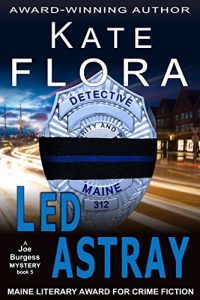 today’s headlines. Joe has settled into a long-term relationship, complete with children, but he’s still, above all, a cop. When he responds to a call from an abandoned warehouse and finds three of his fellow officers shot, one dead, everything in his life recedes except finding the person who is targeting police. Flora does a masterly job of taking us inside Joe’s head, and life as he focuses on possibilities and investigates a scene with few clues, knowing that he, too, could be a target.
today’s headlines. Joe has settled into a long-term relationship, complete with children, but he’s still, above all, a cop. When he responds to a call from an abandoned warehouse and finds three of his fellow officers shot, one dead, everything in his life recedes except finding the person who is targeting police. Flora does a masterly job of taking us inside Joe’s head, and life as he focuses on possibilities and investigates a scene with few clues, knowing that he, too, could be a target.
Jonathan Harr’s THE LOST PAINTING is the slightly fictionalized account of two young Italian art history students and the art historians and restorers they connect with in trying to establish the history of — and find — a lost masterpiece by Caravaggio. Harr doesn’t just recount the steps they took … he takes 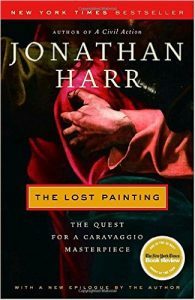 us along to visit dusty archives and two hundred year old auction gallery records, introducing the reader to fascinating people in Italy, England, Scotland and Ireland along the way. For anyone who loves research, history, art, or just a darn good story … this is it.
us along to visit dusty archives and two hundred year old auction gallery records, introducing the reader to fascinating people in Italy, England, Scotland and Ireland along the way. For anyone who loves research, history, art, or just a darn good story … this is it.
WRITTEN OFF by E.J. Copperman (AKA Jeff Cohen) is the first in a new mystery series, whose premise is mysterious to begin with. What if a man claiming to have the same name … and lifestyle … and speech patterns … and a very similar job … to an author’s sleuth, arrives at her doorstep explaining that three mystery authors have been 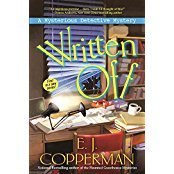 killed and he needs her insights and help to solve the crime … before she becomes the fourth victim? Is he crazy? Is she? Who is this man? And … why are mystery authors being targeted? Copperman/Curtis always writes with wry humor, and WRITTEN OFF is light, fun … and yet … mysterious.
killed and he needs her insights and help to solve the crime … before she becomes the fourth victim? Is he crazy? Is she? Who is this man? And … why are mystery authors being targeted? Copperman/Curtis always writes with wry humor, and WRITTEN OFF is light, fun … and yet … mysterious.
Emily Carpenter’s BURYING THE HONEYSUCKLE GIRLS is poignant and gripping. What if you found out your mother, grandmother, and great-grandmother all died when they were thirty, and your thirtieth birthday is just around the corner. Althea Bell, just out 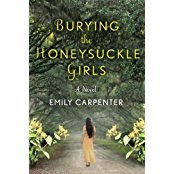 of rehab, is told she doesn’t have much time. To find out why, and whether she can break the pattern, she must investigate her own family history, and, along the way, discover the secrets it hides. With a trace of Gothic tradition, BURYING THE HONEYSUCKLE GIRLS is hard to put down.
of rehab, is told she doesn’t have much time. To find out why, and whether she can break the pattern, she must investigate her own family history, and, along the way, discover the secrets it hides. With a trace of Gothic tradition, BURYING THE HONEYSUCKLE GIRLS is hard to put down.
Clearly I’m fascinated by hidden family secrets from the past, because they’re also the center of B.A. Shapiro’s THE MURALIST. A woman artist working in the WPA (Works Progress Administration) in 1940 and lauded by major abstract expressionists of her time, disappears. Seventy years later her great-niece determines to find out what happened to her and her paintings, and 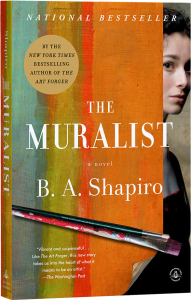 finds unexpected connections to other artists, Hitler’s persecution of Jews in during World War II, and other members of her family. A quest that leads her through the art world of today .. and yesterday.
finds unexpected connections to other artists, Hitler’s persecution of Jews in during World War II, and other members of her family. A quest that leads her through the art world of today .. and yesterday.
And one more with family history presenting both the mystery … and its solution … is Barbara Ross’ ICED UNDER. (Yes, another friend and fellow Maine Crime Writer.) A 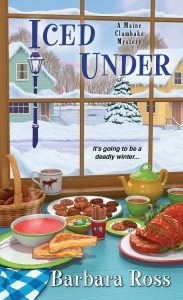 mysterious package containing an extremely valuable piece of jewelry arrives in Maine on a snowy winter day, with no return address. Who sent it? Why? And who is the real owner? Barbara Ross keeps us fascinated until the end, as secrets are gradually revealed.
mysterious package containing an extremely valuable piece of jewelry arrives in Maine on a snowy winter day, with no return address. Who sent it? Why? And who is the real owner? Barbara Ross keeps us fascinated until the end, as secrets are gradually revealed.
I’ve read more … and will write about some of those in the future. But, for now … I’m going to find a cozy corner and another good book to take me away from issues of today into secrets of the past … and into the minds of others braver than I am.
What books are you reading this winter?
Jessie: In New England, wrapped in layers and trying to b...
Jessie: In New England, wrapped in layers and trying to break a fever.
Although it happens rarely, I have been struck down with something nasty. I ache, my coughs could shatter glass and my stomach has made a nuisance of itself for hours.
So, as a distraction I’ve turned my thoughts to something that makes me smile, the cover for my second Change of Fortune Mystery, Whispers of Warning. Looking at it makes me feel like summer may once again return even though snow is pelting my windows. 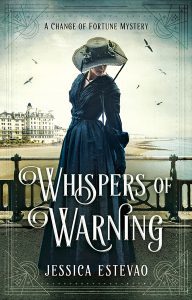
As a way to celebrate it, I am pleased to offer a copy of the first in the series, Whispers Beyond the Veil to one commenter who sends along a cold, flu or general malaise remedy or some other comment to take my mind off my woes.
Good luck and good health!
January 16, 2017
Why’d They Have to Go and CHANGE Things?
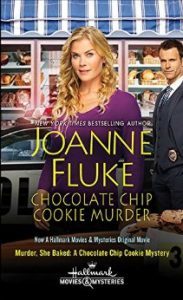 What do the following characters have in common besides the fact that they are all detectives in mystery fiction? Sir Arthur Conan Doyle’s Sherlock Holmes, Agatha Christie’s Hercule Poirot and Miss Marple, Marjorie Allingham’s Albert Campion, Dorothy L. Sayers’ Lord Peter Wimsey, Ellis Peters’ Brother Cadfael, Janet Evanovich’s Stephanie Plum, Joanne Fluke’s Hannah Swensen, Kate Collins’ Abby Knight, Peter King’s unnamed Gourmet Detective, Charlaine Harris’s Aurora Teagarden, Kerry Greenwood’s Phryne Fisher, and Maureen Jennings’ William Murdock.
What do the following characters have in common besides the fact that they are all detectives in mystery fiction? Sir Arthur Conan Doyle’s Sherlock Holmes, Agatha Christie’s Hercule Poirot and Miss Marple, Marjorie Allingham’s Albert Campion, Dorothy L. Sayers’ Lord Peter Wimsey, Ellis Peters’ Brother Cadfael, Janet Evanovich’s Stephanie Plum, Joanne Fluke’s Hannah Swensen, Kate Collins’ Abby Knight, Peter King’s unnamed Gourmet Detective, Charlaine Harris’s Aurora Teagarden, Kerry Greenwood’s Phryne Fisher, and Maureen Jennings’ William Murdock.
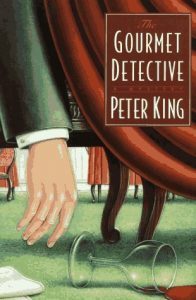 Answer: They’ve all made the transition from page to screen . . . with varying degrees of success.
Answer: They’ve all made the transition from page to screen . . . with varying degrees of success.
Of course there are many more examples. In fact, the second book in Kate Carlisle’s Fixer Upper Mysteries debuted just last Sunday night on the Hallmark Movies and Mysteries channel as “Framed for Murder.”
There have been and will continue to be endless discussions among readers about film portrayals of favorite sleuths, especially if the material has been adapted more than once. Personally, I prefer Joan Hickson as Miss Marple and Jeremy Brett as Sherlock Holmes, but tastes differ, as do screenplays. Some stray mighty far from the source material.
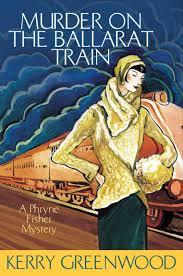 To be truthful, all screenplays take liberties. They have to. We’re talking apples and oranges here. Length alone dictates change. There is no way every detail included in a three hundred page book can be shown in a ninety minute movie. Even if the screen version becomes a TV series, there are limitations. An hour an episode translates into only about forty-five minutes of story.
To be truthful, all screenplays take liberties. They have to. We’re talking apples and oranges here. Length alone dictates change. There is no way every detail included in a three hundred page book can be shown in a ninety minute movie. Even if the screen version becomes a TV series, there are limitations. An hour an episode translates into only about forty-five minutes of story.
Still, those who have read the books often find themselves wondering “Why did they have to go and change things?” I enjoy the Miss Fisher Mysteries, a series from Australian television, but I can’t figure out why they completely revamped the story line concerning Phryne Fisher’s sister.  I like the version in the books better. On the other hand, the Canadian production variously called Murdock Mysteries and The Artful Detective, takes Maureen Jennings’s rather dark Victorian- era Toronto detective and adds humor. I liked the novels but I love the TV series.
I like the version in the books better. On the other hand, the Canadian production variously called Murdock Mysteries and The Artful Detective, takes Maureen Jennings’s rather dark Victorian- era Toronto detective and adds humor. I liked the novels but I love the TV series.
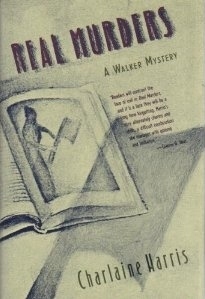 I mentioned that the Fixer Upper mysteries started with a made-for-television movie based on the second book in the series. Hallmark did the same thing with Charlaine Harris’s Aurora Teagarden mysteries. The thing is, if you start with book two, followed by a movie based on book one, the original series timeline no longer works. Roe Teagarden’s love life, among other things, is now very different from the way it is in the books. Better? I’m not certain. You’ll have to read the novels and watch the movies and decide for yourself.
I mentioned that the Fixer Upper mysteries started with a made-for-television movie based on the second book in the series. Hallmark did the same thing with Charlaine Harris’s Aurora Teagarden mysteries. The thing is, if you start with book two, followed by a movie based on book one, the original series timeline no longer works. Roe Teagarden’s love life, among other things, is now very different from the way it is in the books. Better? I’m not certain. You’ll have to read the novels and watch the movies and decide for yourself.
In varying degrees, movies and television series made from mystery novels all end up changing them. They sometime eliminate characters. Sometimes the screenplay even changes the ending. You’d think that if a network liked a series of books well enough to buy the rights to it, they’d keep more of the original story, but it rarely seems to work that way.
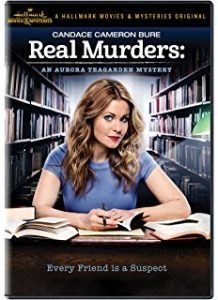 Having said all this, I have two confessions to make. One is that I’m inconsistent in my reactions to movies and TV series made from books. It depends on what the changes are and how much I liked the way things happened in the original version. The other confession is that I enjoy Hallmark movies. Yes, they are sometimes so sweet they make your teeth ache, but I prefer that to dialogue full of f-bombs and plots overburdened with gratuitous sex and/or violence.
Having said all this, I have two confessions to make. One is that I’m inconsistent in my reactions to movies and TV series made from books. It depends on what the changes are and how much I liked the way things happened in the original version. The other confession is that I enjoy Hallmark movies. Yes, they are sometimes so sweet they make your teeth ache, but I prefer that to dialogue full of f-bombs and plots overburdened with gratuitous sex and/or violence.
When all is said and done, though, there is one really good thing that comes about every time a mystery novel is made into a movie or TV series. People go out and buy the book. If they like it, they read more of that author’s books. They may even end up getting hooked on the whole genre, and that benefits all of us who write mysteries.
Kathy Lynn Emerson/Kaitlyn Dunnett is the author of over fifty books written under several names. She won the Agatha Award for best mystery nonfiction of 2008 for How to Write Killer Historical Mysteries and was an Agatha Award finalist in 2015 in the best mystery short story category for “The Blessing Witch.” Currently she writes the contemporary Liss MacCrimmon Mysteries (Kilt at the Highland Games) as Kaitlyn and the historical Mistress Jaffrey Mysteries (Murder in a Cornish Alehouse ~ UK in December 2016; US in April 2017) as Kathy. The latter series is a spin-off from her earlier “Face Down” series and is set in Elizabethan England. Her websites are www.KaitlynDunnett.com and www.KathyLynnEmerson.com
January 15, 2017
MARTIN LUTHER KING, JR. LEGACY: A CONTINUING STRUGGLE
Susan Vaughan here on Martin Luther King, Jr. Day. Given the continuing racial and ethnic divides in the United States, one wonders what the Reverend Dr. King would think of the progress or lack thereof of civil rights. The holiday celebrates the life and legacy of this man who brought hope and change to America. To quote the King Center, “We commemorate as well the timeless values he taught us through his example—the values of courage, truth, justice, compassion, dignity, humility and service that so radiantly defined Dr. King’s character and empowered his leadership. On this holiday we commemorate the universal, unconditional love, forgiveness and nonviolence that empowered his revolutionary spirit.” King’s nonviolent campaigns and eloquent and impassioned speeches led to changes in many laws and the enactment of the Civil Rights Act of 1964. On April 4th, 1968, Martin Luther King, Jr. was shot and killed in Memphis, Tennessee, but his achievements changed the nation.
On this holiday we commemorate the universal, unconditional love, forgiveness and nonviolence that empowered his revolutionary spirit.” King’s nonviolent campaigns and eloquent and impassioned speeches led to changes in many laws and the enactment of the Civil Rights Act of 1964. On April 4th, 1968, Martin Luther King, Jr. was shot and killed in Memphis, Tennessee, but his achievements changed the nation.
He is the leader most often mentioned in connection with the advancement of civil rights, but he was one of many. Who were these “others” and “activists?” Most people know about Rosa Parks, who, on a day in 1955, refused to give up her seat on a Montgomery, Alabama, bus to a white rider, thereby defying a southern custom that required blacks to give seats toward the front of buses to whites. When she was jailed, a black community boycott of the city’s buses began and lasted a year.
But who knows the names of the four African American college freshmen who, in 1960, sat down at a segregated lunch counter at Woolworth’s in Greensboro, North Carolina, and politely asked for service, but were refused.
When asked to leave, they remained seated. Think about this in the context of the segregated South in the 1960’s. These were college freshmen, mere boys, who could’ve been beaten or shot or lynched. How brave they were!
The young men that first day were Ezell A. Blair, Jr, (now Jibreel Khazan), Franklin E. McCain, Joseph A. McNeil, and David L. Richmond. Blair/Khazan went on to graduate while involved in organizing the Student Nonviolent Coordinating Committee (SNCC). He later moved to Massachusetts, where today he works with developmentally disabled people. Franklin McCain graduated and worked as a chemist and continued to be an oral historian of the civil rights movement. He died in Greensboro in 2014. Joseph McNeil earned his degree in engineering physics and joined the U.S. Air Force. While serving, he continued to volunteer in organizations that promoted civil rights. After active duty, he retired from the Air Force Reserves with the rank of Major General. David L. Richmond left college without finishing a degree. He worked as a counselor-coordinator for the CETA program in Greensboro and drifted from job to job. He died in 1990.
On days following the Greensboro Four’s lunch counter sit-in, other students joined, and by week’s end, 3000 students were picketing in downtown Greensboro. This passive resistance and peaceful protest began a wave of student sit-ins designed to end segregation at southern lunch counters. These protests spread rapidly throughout the South and led to the founding of the Student Non-Violent Coordinating Committee (SNCC). This student-led group was more aggressive in its use of nonviolent direct action tactics than King’s SCLC.
A more prominent civil rights leader then was John Lewis, now Congressman Lewis. He was born in Alabama in 1940 and grew up in an era of segregation. Inspired by Martin Luther King Jr., he participated in the Freedom Rides of 1961 and helped plan the 1963 March on Washington for Jobs and Freedom. It was at this event where Martin Luther King, Jr. delivered his “I Have a Dream” speech. Although the Civil Rights Act became law in 1964, its passage law did not automatically make it easy for African Americans to vote in the South. To bring attention to this struggle, in 1965, led by Dr. King, Lewis and others organized marches from Selma fifty-five miles to Alabama’s state capital, crossing the Edmund Pettus Bridge, named for a Grand Dragon of the Ku Klux Klan. Yes, you read that correctly. I believe that’s Lewis on the left in the white vestment. King and his wife are center right.
On Sunday, March 7, after crossing the bridge, the marchers were attacked by state troopers. Lewis was severely beaten severely, suffering a fractured skull. The violent attacks were filmed and broadcast, and the powerful images of what came to be known as “Bloody Sunday” sped up the passage of 1965’s Voting Rights Act.
John Lewis was elected to Congress in 1986 and received the Presidential Medal of Freedom in 2011. March, his memoir of the civil rights movement (with Andrew Aydin and Nate Powell), written as a trilogy of graphic novels, won the National Book Award for Young People’s Literature and the Robert F. Kennedy Book Award.
I’m a white girl who at the time was aware of the civil rights movement but was focused on my studies. I’m ashamed to admit that I did little in support. The efforts and sacrifices of many, many anonymous and famous people led to improvements in civil rights, and many of those same people continue the fight. But if you look around you or read online or print articles, you know we still have a long way to go. Until we as a nation and as a people confront the shameful legacy of slavery and the centuries of its aftermath, we won’t leave behind the racism and ethnic suspicions that weigh us down. As Dr. King said, “Injustice anywhere, is a threat to justice everywhere.”

